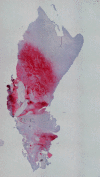One-step bone marrow-derived cell transplantation in talar osteochondral lesions
- PMID: 19449082
- PMCID: PMC2772930
- DOI: 10.1007/s11999-009-0885-8
One-step bone marrow-derived cell transplantation in talar osteochondral lesions
Abstract
The ideal treatment of osteochondral lesions is debatable. Although autologous chondrocyte implantation provides pain relief, the need for two operations and high costs has prompted a search for alternatives. Bone marrow-derived cells may represent the future in osteochondral repair. Using a device to concentrate bone marrow-derived cells and collagen powder or hyaluronic acid membrane as scaffolds for cell support and platelet gel, a one-step arthroscopic technique was developed for cartilage repair. We performed an in vitro preclinical study to verify the capability of bone marrow-derived cells to differentiate into chondrogenic and osteogenic lineages and to be supported onto scaffolds. In a prospective clinical study, we investigated the ability of this technique to repair talar osteochondral lesions in 48 patients. Minimum followup was 24 months (mean, 29 months; range, 24-35 months). Clinical results were evaluated using the American Orthopaedic Foot and Ankle Society (AOFAS) score and the influence of scaffold type, lesion area, previous surgeries, and lesion depth was considered. MRI and histologic evaluation were performed. The AOFAS score improved from 64.4 +/- 14.5 to 91.4 +/- 7.7. Histologic evaluation showed regenerated tissue in various degrees of remodeling although none showed entirely hyaline cartilage. These data suggest the one-step technique is an alternative for cartilage repair, permitting improved functional scores and overcoming the drawbacks of previous techniques.
Level of evidence: Level IV, therapeutic study. See Guidelines for Authors for a complete description of levels of evidence.
Figures










References
-
- {'text': '', 'ref_index': 1, 'ids': [{'type': 'DOI', 'value': '10.1002/(SICI)1097-4636(199811)42:2<172::AID-JBM2>3.0.CO;2-M', 'is_inner': False, 'url': 'https://doi.org/10.1002/(sici)1097-4636(199811)42:2<172::aid-jbm2>3.0.co;2-m'}, {'type': 'PubMed', 'value': '9773813', 'is_inner': True, 'url': 'https://pubmed.ncbi.nlm.nih.gov/9773813/'}]}
- Aigner J, Tegeler J, Hutzler P, Campoccia D, Pavesio A, Hammer C, Kastenbauer E, Naumann A. Cartilage tissue engineering with novel nonwoven structured biomaterial based on hyaluronic acid benzyl ester. J Biomed Mater Res. 1998;42:172–181. - PubMed
-
- {'text': '', 'ref_index': 1, 'ids': [{'type': 'DOI', 'value': '10.1136/ard.51.9.1056', 'is_inner': False, 'url': 'https://doi.org/10.1136/ard.51.9.1056'}, {'type': 'PMC', 'value': 'PMC1004837', 'is_inner': False, 'url': 'https://pmc.ncbi.nlm.nih.gov/articles/PMC1004837/'}, {'type': 'PubMed', 'value': '1417137', 'is_inner': True, 'url': 'https://pubmed.ncbi.nlm.nih.gov/1417137/'}]}
- Altman RD, Kates J, Chun LE, Dear DD, Eyre D. Preliminary observations of chondral abrasions in a canine model. Ann Rheum Dis. 1992;51:1056–1062. - PMC - PubMed
-
- {'text': '', 'ref_index': 1, 'ids': [{'type': 'PubMed', 'value': '2613129', 'is_inner': True, 'url': 'https://pubmed.ncbi.nlm.nih.gov/2613129/'}]}
- Angermann P, Jensen P. Osteochondritis dissecans of the talus: long-term results of surgical treatment. Foot Ankle. 1989;10:161–163. - PubMed
-
- {'text': '', 'ref_index': 1, 'ids': [{'type': 'DOI', 'value': '10.1302/0301-620X.87B5.15905', 'is_inner': False, 'url': 'https://doi.org/10.1302/0301-620x.87b5.15905'}, {'type': 'PubMed', 'value': '15855365', 'is_inner': True, 'url': 'https://pubmed.ncbi.nlm.nih.gov/15855365/'}]}
- Bartlett W, Skinner JA, Gooding CR, Carrington RW, Flanagan AM, Briggs TW, Bentley G. Autologous chondrocyte implantation versus matrix-induced autologous chondrocyte implantation for osteochondral defects of the knee: a prospective, randomised study. J Bone Joint Surg Br. 2005;87:640–645. - PubMed
-
- {'text': '', 'ref_index': 1, 'ids': [{'type': 'DOI', 'value': '10.2106/JBJS.E.00033', 'is_inner': False, 'url': 'https://doi.org/10.2106/jbjs.e.00033'}, {'type': 'PubMed', 'value': '16452741', 'is_inner': True, 'url': 'https://pubmed.ncbi.nlm.nih.gov/16452741/'}]}
- Baums MH, Heidrich G, Schultz W, Steckel H, Kahl E, Klinger HM. Autologous chondrocyte implantation of the ankle: a 2- to 5-year follow-up. J Bone Joint Surg Am. 2006;88:303–308. - PubMed
Publication types
MeSH terms
Substances
LinkOut - more resources
Full Text Sources
Medical
Research Materials

